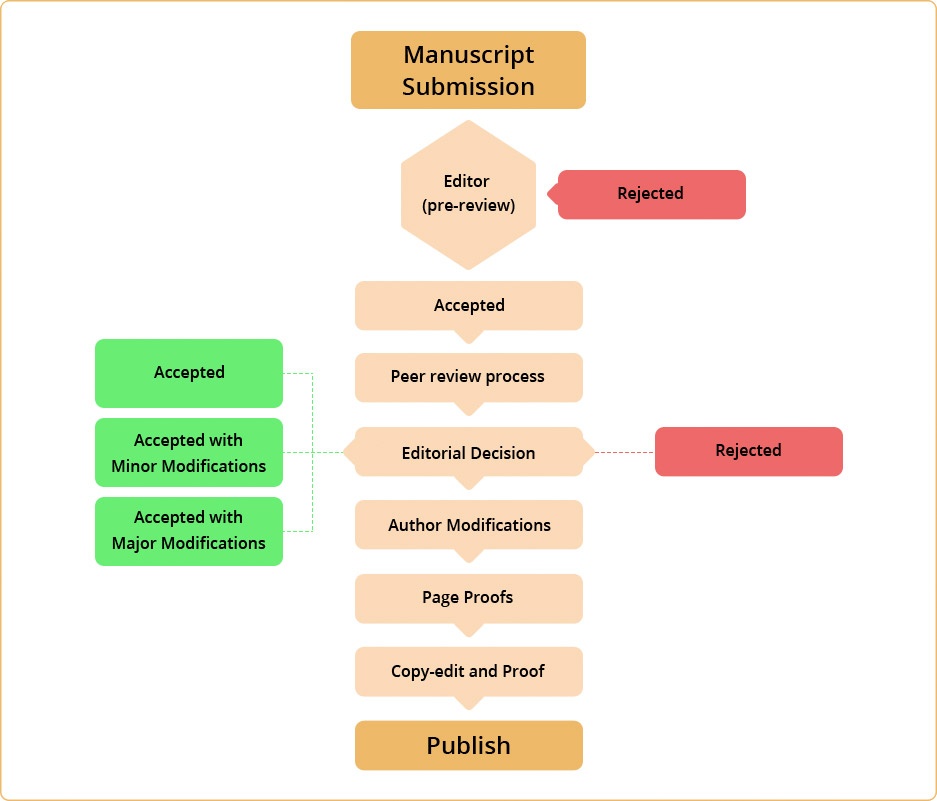Dos & Don’ts of a Successful Journal Submission
A successful peer-reviewed journal publication is a victory in academia. It means your research project has successfully been completed and analyzed; it has been validated by peers in your field and it is now available for other researchers to read. Your published research will now contribute to the knowledge in your field. Furthermore, it is helpful for your career development. Your publication will make your name known to others in your field, it could attract students to your research group and will add to your credibility when you apply for funding. Therefore, publishing your work is an essential part of your academic career. However, publishing a research paper may not be as easy as it sounds. Almost half the papers submitted to a high quality journal are rejected. To increase the chances of successful journal submission, follow the step-by-step advice:
Step 1: How to Select the Right Journal for Publication
The first step is to ensure your manuscript is suitable for the journal you wish to publish it in. Many papers are rejected because they do not fall within the aims and scope of the journal they were submitted to. Choose the best type of journal for your article, for example: review or original research journals and regular or megajournals. Think about the reason you are publishing your work. Most of the time you aim to publish in a high-quality journal with a high impact factor that reaches your target audience. The higher the impact factor, the more prestigious your article; and reaching many readers with an interest in your field, means greater exposure for you and your work. Here, we list some dos and don’ts for journal selection:
Step 1.1: Dos and Don'ts for Selecting the Right Journal
- Dos
- Check the aims and scope of the journal
- Check whether the journal has published work similar to yours
- Check if the journal has restrictions
- Check profiles of peer reviewers for the journal
- Don'ts
- Fall prey to predatory journals
- Focus on the impact factor alone
- Ignore the target audience
- Trust all claims made by a journal
Submitting your paper to the most suitable academic journal will increase your chances of it being accepted for peer review. This will save your time, money, and motivation. But, check that you are happy with the quality of the journal too. Take note of the journal names that you find most of your literature in. These are potential target journals where you can publish your research.
If selecting the right journal feels overwhelming, there is help available. Several journal selection tools like the Enago Open Access Journal Finder help you identify the right journal for your research paper. Usually, these tools allow a user to upload their abstract and then provide a list of top journals that are a perfect match for the manuscript.
Step 1.2: How to use Online Journal Selection Tools/Platforms for Journal Recommendation
DOAJ Database
Publishing your work in an open-access journal will make your paper accessible to more readers. The DOAJ database gives a classification of each journal (whether open access or not), lists the journals that contain the DOAJ seal (certification of the journals openness and best practices).
Scopus
Scopus is the largest database of peer-reviewed literature. Using the “search” function, you can find an appropriate journal for your paper.
FindMyJournal
This large catalogue of journals can be used to search for suitable journals in your field.
OAJF (Enago Open Access Journal Finder)
To find a high quality open-access journal, you should use this platform. This platform helps you avoid predatory journals, check journal authenticity as well as any related article processing fees.
Elsevier Journal Finder
This platform uses your title and abstract to help you find an appropriate journal for your publication from Elsevier's portfolio of academic journals.
There are many more platforms available to help with your journal selection. Try a few of them when selecting your journal and see if they come up with the same results. A great line to remember when selecting a journal for your paper is “Think.Check.Submit”.
Step 1.3: What Does Predatory Publishing Mean?
As mentioned above, beware of predatory publishers. These publishers exploit academics. They make money by charging high publication fees. Their journals are not listed by accredited journal platforms such as the DOAJ. These journals are not peer-reviewed and publishing in such a journal will be a serious waste of your effort as it will most likely not be read by experts in your field. You can check whether a journal is predatory on “Beall’s list of predatory journals and publishers”. This way you won’t be caught out. In addition, use “Think.Check.Submit” to help you confirm the validity of a journal by asking yourself the following questions:
Think:
- Are you submitting your research to a trusted journal?
- Is the journal relevant to your research field?
Check:
- Have you or your colleagues heard of this journal before?
- Can you contact the publisher?
- Does the journal describe the type of peer review it uses?
- Does the site explain what the fees are for?
- Have you checked the profiles of the editorial board members?
Submit:
- If you are happy with the answers to the questions above
- If your paper will be easily discoverable
- If you receive a professional review and publishing experience
Struggling with writing your research paper?
Enago Learn can guide you through the manuscript preparation process and help you achieve success
Start Learning Now
Step 2: How to Draft a Publishable Manuscript
While drafting your research paper, you may think the text is the most important part of your paper, but it is not so. It is actually your title, abstract, and keywords that will help readers find your article when they perform a search. This is because electronic databases, search engines and journal websites use keywords from your title, abstract and keywords to categorize your paper for potential readers. Therefore, it is vital to write a relevant title, abstract and use the correct keywords. Here we list some do’s and don’ts to help you write an effective title:
Step 2.1: Dos and Don'ts for Drafting an Attractive Research Title
- Dos
- Do keep your title specific
- Do start with the articles subject matter
- Do make your title interesting
- Do highlight the core research
- Don'ts
- Use abbreviations and jargon, unless they are well known
- Make your title too long
- Write an ambiguous title
- Use repetitive or unnecessary words
- “A Study of the Safety and Efficacy of 10 mg X Drug as a Smoking Cessation Intervention for People who Smoke More than 10 cigarettes per day”
- “Safety and Efficacy of 10 mg X Drug as a Treatment to Aid Smoking Cessation”
Step 2.2: Key Points While Writing the Different Sections in a Manuscript
- Authors: Only authors who have made a substantial contribution to the research may be listed. They also need to take responsibility for the data and conclusions.
- Abstract: Summarize each section of the article namely objective, methods, results and conclusions. It should be approximately 200 words in length.
- Introduction: A brief background in which your research is placed in context. This gets narrowed down to your research questions
- Methods: Give enough details for readers to repeat your experiments. If you’re using published research, cite the original work and detail any modifications. If your methods section is new, write them out in full. Remember to include ethics statements (if any).
- Results: State the results of your research without discussing them. You can use text, figures, tables and graphs.
- Discussion and Conclusions: Describe what your results mean in the context of the literature. Link this back to your research questions in your introduction.
- Acknowledgements: Briefly name anyone who helped with your research. Disclose any substantive conflict of interest.
- References: Check the reference style of your target journal for the format of citations and references.
Step 2.3: Importance of Editing and Proofreading After Drafting Your Manuscript
- Once your draft is complete, it is time to edit and proofread your manuscript. It is important to edit and proofread because a manuscript with a bad layout, spelling errors, and illogical flow will be rejected before the peer review process. Create an outline of your paper and check that the ideas flow logically in your manuscript. Once you have arranged all the sections into a logical order, you can edit each section in detail.
- Divide your manuscript into short sections for editing and proofreading. You need fresh eyes to spot mistakes.
- When revising, check each section to ensure it is written clearly. One way to pick up mistakes is to read the section out loud. Your ears may pick up a mistake that your eyes have missed. Another way is to print out a hard copy and read it line by line.
- Ensure both your spelling and grammar is correct. In addition, check that you have labeled your tables and figures correctly and are referring to the correct tables and figures in your text. Once you are happy with the manuscript, ask a friend, colleague or professional editing and proofreading service to check your work.
Planning to publish your manuscript?
With Enago’s English Editing & Proofreading service your success is just a step away
Submit Your Manuscript
Step 3: How to Write a Cover Letter for Journal Submission
Drafting an effective cover letter for your journal submission may turn out to be the key to your manuscript being accepted by the journal.
Step 3.1: Importance of a Cover Letter During Journal Submission
It is worth investing some time writing a powerful cover letter for your journal article submission. It is a good opportunity to tell the journal editor why your research is new and significant. The editor needs to decide whether your article will attract interested readers so they can sell their journal. Therefore, your cover letter needs to be a “sales pitch” that persuades the editor to consider your article for the review process.
Step 3.2: Format of the Journal Submission Cover Letter
Most journals require a similar format for the cover letter. However, first check the “instructions for authors” of the journal you are submitting your paper to. This will tell you if you need to include any specific information. Check for an example of what your cover letter could look like.
Step 3.3: Additional Information
- a list of potential reviewers (with contact information)
- a list of other similar manuscripts that you are working on or are awaiting review with another journal.
- sources of research funding
- acknowledgements (if any)
Step 3.4: Dos & Don'ts for an Effective Cover Letter
- Dos
- Be concise
- Write clearly and concisely
- Put your work in context
- Check spelling and grammar
- Don'ts
- Use highly technical jargon or acronyms
- Address your letter to "Dear Sir"
- Exaggerate your findings
- Use humor
Step 4: How to Avoid Plagiarism in Your Research Paper
Plagiarism is a serious offence. Hence, to avoid plagiarism in your research paper ensure that you cite other’s work correctly. Here are some tips on how to avoid plagiarized content in your manuscript:
- Read the literature thoroughly and ensure you understand the work.
- Use your own words to describe ideas.
- You must cite the ideas of others, even though you have used your own words.
- Place quotes around quoted text and cite the author.
- Do not copy and paste text directly into your manuscript.
- Cite references correctly according to the journal’s referencing style.
- Do not self-plagiarize. Cite any of your own published work. Remember the publisher of the journal owns the copyright.
- Use an anti-plagiarism tool to check your manuscript.
As mentioned above, there are several plagiarism detection tools available to help you detect accidental plagiarism in your manuscript. These tools include Grammarly, iThenticate, PlagScan and CrossRef. They all perform cross checks of your manuscript with millions of web pages and scholarly databases. Of these four plagiarism detectors, Grammarly is the only free tool.
Manuscript ready for submission?
Send your manuscript to Enago’s Plagiarism Check service for plagiarism checking before the final submission.
Check for plagiarism
Step 5: Journal Submission Checklist
Use this Checklist to ensure your manuscript is submission-ready:
Target Journal Selection
- The aims and scope of the journal are aligned with the title of the research paper.
- Journal has previously published similar work.
- Journal is not predatory.
Cover Letter
- Conforms to journal’s author guidelines (if any).
- Places your research in context with the journal’s aims and scope.
- No highly technical jargon or acronyms used.
- Language and grammar checked.
- Formatting errors removed by proofreading.
- Requested documents are attached.
Manuscript
- Follows author’s guidelines.
- Has concise and specific title
- Abstract contains concise details of your objectives, methods, results and conclusion.
- Keywords added.
- Conflicts of interest are listed (if any).
- Acknowledgements are included.
- Corresponding author contact information added.
- Plagiarism check performed.
- References are accurate and formatted according to the journal’s referencing style.
- Language and grammar checked.
Step 6: Submitting the Manuscript to the Target Journal
There are two ways to submit manuscripts:
Step 6.1: Offline Submission of Manuscripts
Details will be given under author guidelines, usually the manuscript is emailed to the editor.
Step 6.2: Online Submission of Manuscripts
The journal will normally have a “submit your paper” or “submit online” link on the publisher’s website. Electronic manuscript systems are used by publishers to manage submissions to their journals. These include ScholarOne, Editorial Manager and Evise®. The following steps should be followed for online submissions:
Step 1: Register as a user.
Step 2: Enter the required information.
Step 3: Upload your document.
Step 4: Review your uploaded document to ensure it uploaded correctly.
Step 5: Some programs allow you to track the status of your article.
Not aware how to submit the manuscript to a target journal?
Let us complete the tedious process on your behalf.
Submit to the Journal
Step 7: What Next after Journal Submission?
You’ve submitted your article and are anxiously awaiting the outcome. Do you follow up? How long should you expect to wait for a response?
Most publishers have the process of “what happens next” outlined under their “author” section on their webpage. This will give you some idea of the timeframe for your journal submission.
Typical journal review process:
Time frames depend on the journal and its peer-reviewers. However, the whole process can take 3-4 months. If you have not heard from the editor after 6-8 weeks, you should contact them to follow up.

Step 8: What if the Journal Rejects the Manuscript?
Not all manuscripts get accepted after the journal submission. Several manuscripts get rejected during the process.
Step 8.1: What are the Common Reasons for Journal Rejection?
- Not within scope of journal
- Poor grammar and spelling
- Lack of structure
- Inappropriate analysis
- Incomplete data
- Inaccurate conclusions
- Author instructions not followed
- Methodology inappropriate or not detailed enough
- Ethics requirements not fulfilled
- References lacking or heavy self-citations.
Step 8.2: What to do after Journal Rejection
Your next step depends on the reason your manuscript was rejected. Here are some options:
- Don’t despair, manuscript rejection is common in academia.
- If your manuscript was out of scope, resubmit it to a more suitable journal.
- Consider reviewer’s comments, make changes and resubmit to a different journal.
- Make no changes and resubmit to another journal.
- Appeal the rejection if you feel strongly about it.
Step 8.3: Ways to Avoid Journal Rejection
- Avoid journal rejection by paying attention to detail.
- Check your manuscript and ask others to check it for you too.
- Ensure your grammar and spelling are correct and that your manuscript is telling your story in a clear, logical manner.
